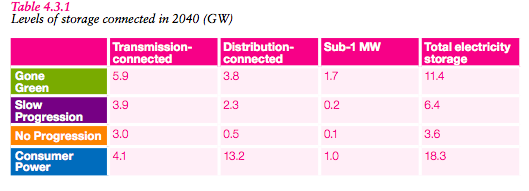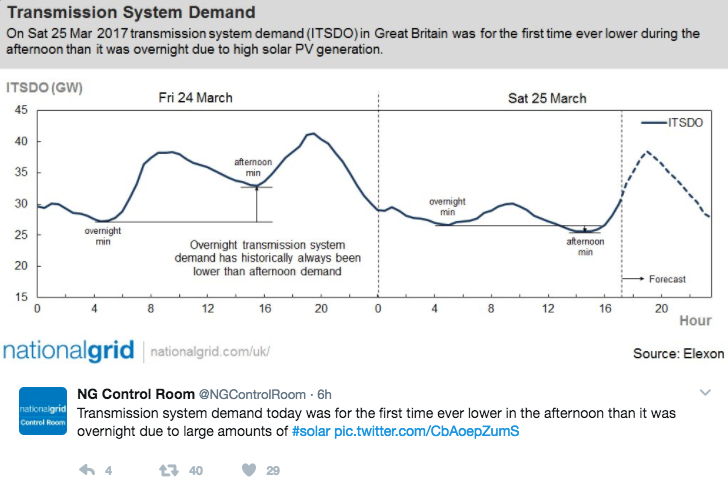 Sunny weather on Saturday made history, according to National Grid. Solar PV connected to the distribution system reduced the draw on the main transmission system in the afternoon to a lower level than it had been overnight on Friday.
Sunny weather on Saturday made history, according to National Grid. Solar PV connected to the distribution system reduced the draw on the main transmission system in the afternoon to a lower level than it had been overnight on Friday.
That has never happened before, said the system operator.
“On Saturday 25 March 2017 transmissions system demand in Great Britain was for the first time ever lower during the afternoon than it was overnight due to high solar PV generation,” National Grid’s control room said via Twitter.
Duncan Burt, National Grid’s head of real time operations, used the same platform to suggest solar was literally “turning GB grid demand upside down”.
Solar makes business case for battery storage
Installed solar PV capacity increased 19% to 11.46GW in the year to December 2016, according to government data, with a further 3GW in the planning system. The technology is the UK’s single biggest form of renewable generation, if offshore and onshore wind are counted as separate categories.
The growing volume of wind and solar is creating a significant challenge for National Grid.
On a sunny, windy day, like Saturday 25 March, the system operator would have paid generators not to export their power onto the transmission system simply because there was nowhere for it to go.
While paying wind farms to turn off tends to rile some sections of the press, and their readers, the system operator has to keep the transmission system stable at 50Hz. Too much power drives up frequency. Too little creates a drop. Both situations, if not quickly managed, could, in the worst case scenario, lead to total system blackout.
Meanwhile, virtually all solar PV is connected to the distribution network, which is controlled by regional grid operators, giving National Grid limited visibility of what is happening on the system and where. That compounds the challenge of balancing the national system and which is why National Grid and local network operators such as Western Power Distribution are trialling ‘footroom’ services, which ask businesses to use more power or turn off their on-site generation and draw from the grid when there is too much power on the system.
Demand-Turn Up (DTU) is one such service. Launched last year, National Grid this year extended DTU so that it runs from March to October. However, Saturday’s sunny weather came two days before the 2017 service commences.
In the longer term, battery storage could absorb excess power from renewable generation, and provide extra capacity when there is less sun and wind.
But there is some debate around how great a role storage will play, and how quickly.
Gigawatts when?
While government recently suggested around 4GW of battery storage may be in operation by 2033, policymakers have a chequered record of reading market auguries.
National Grid has forecast a range of estimates for storage by 2040. While its lowest forecast is not dissimilar to government’s latest projections, its high end scenario tops 18GW.

Meanwhile, Carbon Brief reports that National Grid system operator director, Cordi O Hara, has suggested that 8GW of battery storage could be connected within five years if costs continue to fall at the current rate.
Other market participants also believe a storage ‘boom’ is more imminent. Centrica, for example, predicts a “rush of investment … to start being noticeable from June this year.”
With summer peak demand falling 10% year on year, the system operator will probably be hoping that prediction is closer to the mark than the government’s.
Related stories:
National Grid procures 138.6MW of demand turn up to balance solar in summer
National Grid to extend demand turn-up running hours, procure more
Greg Clark calls for carmakers and energy firms to deliver battery storage
National Grid mulls rolling all frequency balancing services into one scheme
National Grid says impact of solar requires greater system flexibility
Battery storage: Positive outlook or does a correction loom?
Open Energi and Camborne Energy Storage take Tesla battery into frequency response market
Scottish Power asks Ofgem to change classification of batteries in capacity market
Centrica: Floodgates to open on battery storage this summer
UK Power Networks receives 12GW of battery storage applications in 15 months
National Grid boss: future of energy is demand not supply
National Grid says impact of solar requires greater system flexibility
Restore signs 25MW demand turn up deal with National Grid
Flexitricity launches demand turn up service
Demand turn-up: What worked, what didn’t?
Western Power Distribution ramps up demand-response trials, calls for participants
Smart grids ‘require local control and businesses must play or pay’
More than half of I&C firms mulling energy storage investment
National Grid says UK will miss 2020 targets, predicts big battery future
Free demand-side response report
Follow us at @EnergystMedia. For regular bulletins, sign up for the free newsletter.




